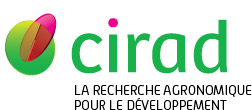Castro Pacheco Sergio Antonio, Rabekijana Ravo, Andriamiarana Mahevanirina, Raveloson Harinjaka, Rakotomalala Joël, Ramanantsoanirina Alain, Garin Vincent, Grenier Cécile, Vom Brocke Kirsten. 2024. Participatory Plant Breeding to develop biofortified upland rice for marginal environments. Experimental Agriculture, 60:e26, 19 p.
|
Version publiée
- Anglais
Sous licence  . .
participatory-plant-breeding-to-develop-biofortified-upland-rice-for-marginal-environments.pdf Télécharger (931kB) | Prévisualisation |
Résumé : In the Highlands of Madagascar, where rice is the main staple food, explosive demographic growth has driven the need for the development of upland rice. In that context, a Participatory Plant Breeding (PPB) program conducted by the FOFIFA-Cirad partnership, aims to develop upland rice varieties adapted to farmers' needs, with superior agronomic performances, and with high grain zinc concentration. In the area, where ferralitic soils with N and P deficiencies prevail, limited fertilizer usage persists due to elevated costs, and upland rice varieties must adapt to these low fertility environments. Thus, this paper aims to identify the adequate selection conditions and methods that allow combining the above-mentioned criteria for selection. So, 56 rice breeding lines, including high-zinc genotypes, were evaluated in field trials with contrasting fertility conditions. A relative selection efficiency analysis demonstrated that selection for yield should be done in moderate fertility environments, while selection for grain zinc concentration could be done across a diverse range of conditions. Through participatory evaluations, we identified that, for this case, grain appreciation was the most important character for deciding whether to select a line, followed by productivity and earliness. We also noted that farmers were more willing to accept a variety if it had higher grain zinc concentration. Finally, we proposed a selection index that combines agronomic, farmers' and nutritional criteria, with the purpose of selecting lines that fulfill the expectations on these areas. Overall, this paper proposes an adapted methodology for the combination of PPB and biofortification in marginal environments.
Mots-clés Agrovoc : sélection végétale participative, amélioration des plantes, riz pluvial, variété, critère de sélection, biofortification, génotype, caractère agronomique, riz, Oryza, amélioration génétique, Oryza sativa, approche participative
Mots-clés géographiques Agrovoc : Madagascar
Mots-clés libres : Upland rice, Biofortification, G × E interactions, Participatory Plant Breeding, Relative selection efficiency, Selection index
Classification Agris : F30 - Génétique et amélioration des plantes
Champ stratégique Cirad : CTS 2 (2019-) - Transitions agroécologiques
Agences de financement hors UE : Consortium of International Agricultural Research Centers
Projets sur financement : (FRA) Agriculture for Nutrition and Health, (FRA) CGIAR Research Program (CRP) on rice agri-food systems, (USA) Rice biofortification in Madagascar
Auteurs et affiliations
-
Castro Pacheco Sergio Antonio, CIRAD-BIOS-UMR AGAP (MDG)
 ORCID: 0000-0001-5946-289X - auteur correspondant
ORCID: 0000-0001-5946-289X - auteur correspondant
- Rabekijana Ravo, FOFIFA (MDG)
- Andriamiarana Mahevanirina
- Raveloson Harinjaka, FOFIFA (MDG)
- Rakotomalala Joël, FOFIFA (MDG)
- Ramanantsoanirina Alain, FOFIFA (MDG)
- Garin Vincent, CIRAD-BIOS-UMR AGAP (FRA)
-
Grenier Cécile, CIRAD-BIOS-UMR AGAP (FRA)
 ORCID: 0000-0001-5390-8344
ORCID: 0000-0001-5390-8344
- Vom Brocke Kirsten, CIRAD-BIOS-UMR AGAP (FRA)
Source : Cirad-Agritrop (https://agritrop.cirad.fr/610874/)
[ Page générée et mise en cache le 2024-12-18 ]




